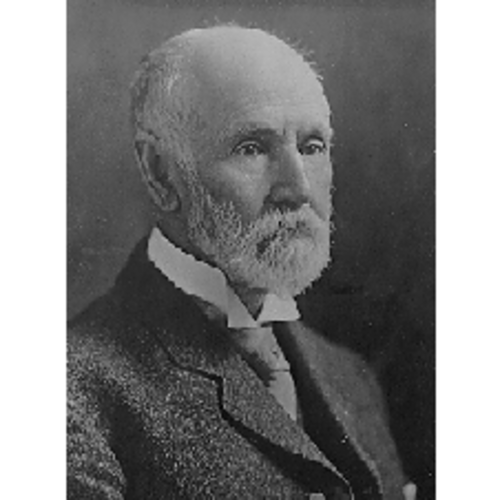![[photo of Nathan Fellowes Dupuis]; Nathan Fellowes Dupuis Original title: [photo of Nathan Fellowes Dupuis]; Nathan Fellowes Dupuis](/bioimages/w600.14455.gif)
Source: Link
DUPUIS, NATHAN FELLOWES, teacher and scientist; b. 13 April 1836 in Portland Township, Upper Canada, third son of Joseph Wells (Dupuis) and Eleanor Baker; m. first 1860 Amelia Ann McGinnis (d. 1905) of Watertown, N.Y., and they had four children, two sons and one daughter reaching adulthood; m. secondly 2 May 1906 Mae Gordon Thompson in Kingston, Ont.; they had no children; d. 20 July 1917 in Long Beach, Calif.
Joseph Dupuis was born in Lower Canada and, after serving in the War of 1812, eventually bought a farm in Portland Township. He took the name of Wells but his son Nathan would revert to his father’s original surname. Showing early a gift for combining deductive reasoning and the skilful use of his hands, Nathan Dupuis was apprenticed at the age of 14 to a Kingston clockmaker, William Smith, after building a clock from materials found on the family farm. Some three or four years later he began teaching school. He also developed a taste for mathematics, and in 1863 he entered Queen’s College in Kingston. He graduated with a ba in 1866, when he was ten years older than was normally the case with students, and was named librarian of Queen’s. In 1867 he received an ma and the following year he was appointed professor of chemistry and natural history, that is, all the sciences except theoretical physics. His real interest lay in mathematics, in which he was made professor in 1880. With new appointments to natural history that year, and to chemistry and physics in 1883, he was able to specialize in that subject. He had published a college text in mathematics in 1868, The elements of geometrical optics, and from 1889 to 1911 was to write another six in various branches of mathematics and astronomy. He used these volumes until he retired from active teaching in 1911. He also constructed most of the apparatus used in his classes, and he designed and built the clock for the tower in Grant Hall.
An untiring advocate for the teaching of “practical science” at Queen’s, Dupuis supported the efforts of Sandford Fleming and George Monro Grant* to establish in 1893 the School of Mining and Agriculture at Kingston. At the insistence of Premier Oliver Mowat*, the school was given autonomous status with only a nominal affiliation to Queen’s College in order to avoid complaints that public support was being given to a denominational institution. As a consequence, Dupuis promoted a faculty of applied or practical (the terms were used interchangeably) science. The proposal was approved by the senate in 1894 and Dupuis was named dean; as dean, he represented the faculty in the school, but the title conferred no power and the faculty was no more than a shell with the science departments under the effective control of William Lawton Goodwin, the school’s director. There, as the professor of mechanism, Dupuis taught mathematics and practical mechanics.
Dupuis’s forte was as a teacher, where both his clear method of exposition and his ability to demonstrate by manual methods stood him in good stead. But his mathematics was of ancient vintage, founded on Euclid and Newton, and he had little liking for the research current in Germany and elsewhere that was bringing advances in mathematics, physics, and electrical engineering. With new curricula entering engineering schools (the School of Mining became one early in the 20th century), his conservative outlook tended to hinder the development of appropriate courses at Queen’s.
Dupuis is remembered more for the building of institutions than for contributions to mathematics or science. He helped Queen’s become a modern university, with the teaching of science and engineering at its core. He was a charter-member of the Royal Society of Canada in 1882 and president of his section in 1896. Although Dupuis published widely, contributing many articles to the Queen’s Quarterly after it was started in 1893, he was not distinguished for his work in the many subjects that interested him. He was, in fact, made obsolete by the very specialization he had helped to bring about. Dupuis Hall, the home of chemical engineering and computing at Queen’s University, is named after him.
Queen’s College Journal (Kingston, Ont.), 1873–93, continued as Queen’s University Journal, 1893–1911. J. Matheson, “Nathan Fellowes Dupuis,” Some great men of Queen’s . . . , ed. R. C. Wallace (Toronto and Halifax, 1941), 51–70. Norman Miller, “Nathan Fellowes Dupuis,” Queen’s Rev. (Kingston), 43 (1969), no.1: 2–8. H. [M.] Neatby and F. W. Gibson, Queen’s University, ed. F. W. Gibson and Roger Graham (2v., Kingston and Montreal, 1978–83), 1. Queen’s College and Univ., Calendar (Kingston), 1868/69–1910/11. Standard dict. of Canadian biog. (Roberts and Tunnell), vol.1. Jane and Costas Varkaris, Nathan Fellowes Dupuis: professor and clockmaker of Queen’s University, and his family (Toronto, 1980).
Cite This Article
Mario Creet, “DUPUIS, NATHAN FELLOWES,” in Dictionary of Canadian Biography, vol. 14, University of Toronto/Université Laval, 2003–, accessed January 13, 2026, https://www.biographi.ca/en/bio/dupuis_nathan_fellowes_14E.html.
The citation above shows the format for footnotes and endnotes according to the Chicago manual of style (16th edition). Information to be used in other citation formats:
| Permalink: | https://www.biographi.ca/en/bio/dupuis_nathan_fellowes_14E.html |
| Author of Article: | Mario Creet |
| Title of Article: | DUPUIS, NATHAN FELLOWES |
| Publication Name: | Dictionary of Canadian Biography, vol. 14 |
| Publisher: | University of Toronto/Université Laval |
| Year of publication: | 1998 |
| Year of revision: | 1998 |
| Access Date: | January 13, 2026 |



